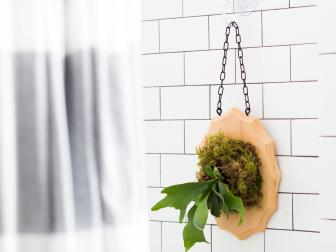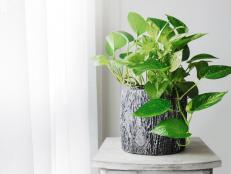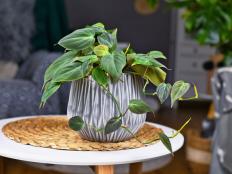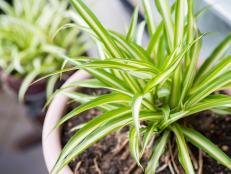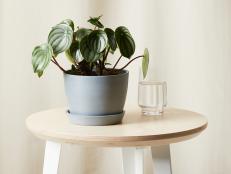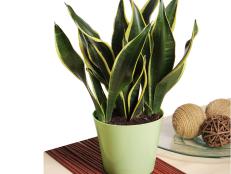Growing and Caring for Staghorn Fern
Learn how to grow and display staghorn fern — a houseplant that makes a real statement with its antler-like, emerald-green fronds.
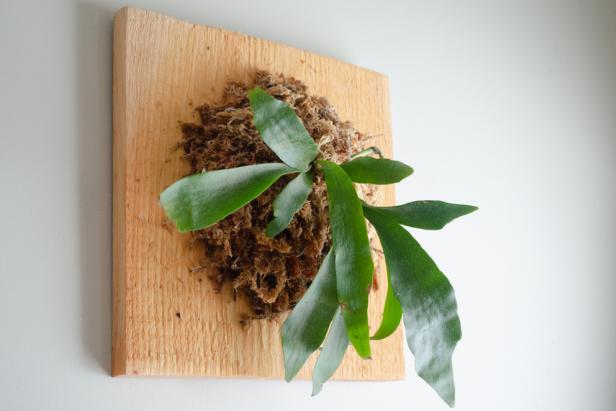
Shutterstock/Pegasene
Staghorn ferns are happy in spaces with bright, indirect light and moderate to high humidity. Wall-mounting is a popular way to display a staghorn fern.

For plant collectors of all persuasions, staghorn fern is not just a plant but a statement piece. As much a work of art as a botanical specimen, staghorn fern features antler-like, emerald green fronds that reach for the light and elegantly drape over the plant’s domed base. Wall-mounted staghorn ferns bring dynamic energy and verdant color to spaces of any style, making them a darling of DIYers everywhere.
All About Staghorn Fern
Staghorn fern (Platycerium bifurcatum), also known as elkhorn fern, is an epiphytic plant hailing from the rain forests of Java, New Guinea and Southeast Asia, according to University of Wisconsin-Madison’s Cooperative Extension. As an epiphyte that gets its moisture and nutrients from the air, staghorn ferns grow attached to trees rather than in soil.
Botanical name: Platycerium bifurcatum
Common Name: Staghorn fern, elkhorn fern
Special Features: Strap-like green fronds resembling antlers
Plant Type: Epiphyte
Size: 2-3 feet tall and up to 3 feet wide
USDA Hardiness Zones: 9 and above
The Platycerium genus includes 18 species of staghorn fern, spanning Africa, Australia and Southeast Asia. Platycerium bifurcatum is the most widely available species, as it takes kindly to common household conditions. Staghorn fern is hardy to zones 9 and above, tolerating temperatures above 40 degrees.
It’s easy to see where staghorn fern gets its name — the strap-like green fronds are forked, resembling antlers, with some growing upright and others draping. These strap-like fronds are the fertile part of staghorn fern; in optimum conditions, they’ll eventually produce brown spores on the undersides of their tips.
Look closely at a staghorn fern and you’ll notice more rounded fronds clustered near the base — some green and others possibly brown. These lower fronds are there for protection rather than reproduction. In nature, these basal — or shield fronds — grow in a dome-like form to partially encapsulate the roots, trapping moisture and debris to sustain the barnacle-like plant. Pistils Nursery has a helpful image illustrating the anatomy of a staghorn fern.
Best Place to Put a Staghorn Fern
If your indoor space has bright, indirect light and moderate to high humidity, give staghorn fern a try. Requiring attentive and specialized care, these aren’t necessarily beginner-friendly plants. Still, for those committed to learning their quirks, staghorn ferns are stunning elements of living decor that can be quite long-lived and well worth the effort.
Growing Staghorn Fern
Making Staghorn Fern Happy
Staghorn fern thrives in 50-75 degree temperatures with moderate to high humidity. Growing medium must be kept moist and humidity maintained, mimicking the tree-dwelling rainforest conditions that staghorn ferns love. Growing medium must also be very well-draining.
The phrase “bright, indirect light” is a vague, slippery phrase. We might think we have it, but do we really? In Darryl Cheng’s book The New Plant Parent, he encourages indoor gardeners to invest in a light meter and to monitor the foot candles in various parts of the house. Plants see light differently than we do, so measuring light allows us to care for them with confidence. Staghorn fern thrives near large windows or skylights, situated where it receives no direct sunlight. Use a light meter to find a spot that receives at least 300 light candles during the day — preferably with highs of 500-600 — for staghorn fern. Artificial light is not sufficient.
Potting Staghorn Fern
Staghorn fern may be grown in a pot, in a basket or wall-mounted on wood. If you’d like to grow staghorn fern as a traditional, potted houseplant, the plastic nursery pot can simply be set into a slightly larger, decorative pot. This way, you can pull out the plastic pot to soak the roots at watering time.
When you purchase a staghorn fern, it will likely come in a 5- to 6-inch pot in a well-draining soil mix designed for tropical plans. Potted ferns must be repotted in spring every two-to-three years in a fresh, well-draining soil mix.
Bundling the root ball in sphagnum moss (instead of potting it in soil) enables staghorn to grow more like it would in the wild. Try growing staghorn fern upright in a basket, nestled into a bed of moist sphagnum, where the fronds can elegantly fold, reach and drape. Baskets reveal more plant anatomy and moss lends a more natural aesthetic than traditional pots can.
Wall-Mounting Staghorn Fern
Also utilizing sphagnum moss, wall-mounting staghorn fern is a popular way to satisfy its craving for light-filled, lofted living, while adding a striking decor element to your space. Much like living walls or air plant displays, wall-mounted staghorn ferns lend vibrant energy to a room. Dive into this DIY tutorial on wall-mounting staghorn fern. Mounting is popular for its interior design impact. In addition to boards, large bark chips are useful, natural mounting surfaces.
How to Mount a Staghorn Fern
Take these beauties out of the pots, and put them on the walls in minutes with this simple DIY tutorial.
Knowing that staghorn fern requires bright, indirect light, be sensible about placement. It’s easy to be tempted to wall-mount a staghorn fern where it would best complement the decor. However, if you prioritize your wants over its needs, that pop of green your staghorn provides will surely be short-lived. Instead, trust that wherever your plant best thrives, it will give you the most prolonged enjoyment, even if that means hanging it in your bathroom.
In Tovah Martin’s book, The Unexpected Houseplant, she shares images of a beautiful wire-basket grown staghorn and offers her original idea of mounting a staghorn fern on the front door during summertime — “where normal people have their knockers.” Just don’t try the front door idea if yours receives direct sunlight.
Buy Growing Books
Staghorn Fern Care
Watering Staghorn Fern
Consistent watering is key to staghorn fern success. Keep the growing medium moist from spring to fall, letting it dry a bit on the surface between waterings. In winter, it’s okay for the growing medium to dry more fully between waterings, since growth is slower, according to Fran Bailey and Zia Allaway’s Practical Houseplant Book. When possible, room temperature, filtered water or rainwater is ideal.
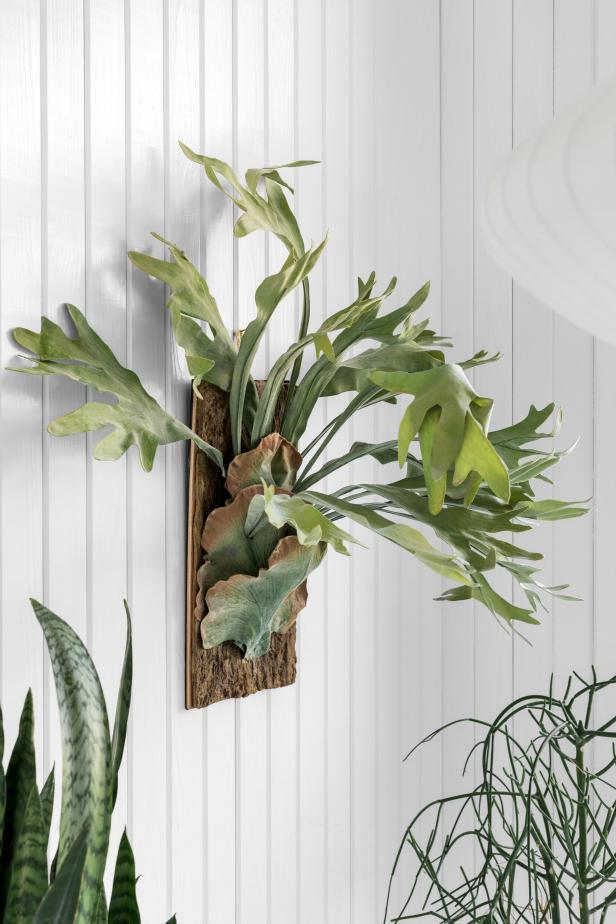
Flynnside Out
Mounted staghorn ferns are grown in sphagnum moss, which retains water better than bark-based potting mix. It's time to water the fern if the moss is dry around the edges.
Potted staghorn ferns may be watered by placing the pot in a tray of water and allowing the roots to drink for 15 minutes or more. Once the soil mix feels thoroughly saturated, allow the pot to drain before putting it back in its decorative pot or pebble tray.
Mounted or basket-grown ferns are grown in sphagnum moss, which retains water better than bark-based potting mix. Still, their heightened air exposure leads to quicker evaporation. Monitor for thirst by feeling the moss: It's time to water if it’s dry around the edges. The best way to water is to lay the moss-covered roots in a sink or basin and give them a good soak, pouring water over the root ball to deeply saturate. Carrying the whole plant into the shower to give it a thorough, root-soaking rinse is a popular strategy. This can also be done with an outdoor hose when the weather is warm. Depending on how your fern is affixed to its mounting board, you may either remove it from the wood, or carry the whole display into the shower. It’s okay if the wood gets wet — keeping the mount intact is the surest way to avoid damage. Once the moss is saturated, allow the plant to drip-dry before re-hanging.
To increase humidity, potted ferns may be placed on a tray of wet pebbles. For any potting arrangement, misting the leaves using a room humidifier or hanging in a bathroom are simple ways to improve hydration.
Fertilizing Staghorn Fern
Staghorn ferns should be fertilized monthly with a balanced, diluted liquid fertilizer (like this one from Good Dirt). A healthy dose of fertilizer when you see new fronds appear encourages vigorous growth.
Staghorn Fern Frond Care
A popular question is: "Should you remove dead leaves from a staghorn fern?"
You’ve learned that staghorn ferns have both linear, fertile (or antler) fronds and rounded, shield (or basal) fronds. Since these fronds serve different purposes, they have different needs. Both types of fronds will turn from green to yellow or brown over time. Pruning out browned fertile fronds is just fine, as the plant has likely already grown new ones and pruning the old ones won’t impact the reproductive cycle.
For shield fronds, it’s a different story. These lower-growing fronds create a protective dome over the root ball to provide protection and sustenance, so tampering with these fronds can damage the root ball. Older shield fronds will turn brown and eventually fall off when they are no longer needed. New shield fronds form each season in optimal conditions.
Staghorn Pests
Scale insects are a common issue for staghorn fern. Houseplant Journal has helpful closeup photos for scale identification. Scale insects are small, white or dark brown bugs with an elliptical, dome-shaped body. They leave behind a sticky honeydew, which you may see on the leaves or surrounding furniture. Pry these bugs off with a knife or fingernail if you see a few. To manage infestations, snip off and discard damaged leaves and stems. Insecticidal soap and neem oil may be used to control scale, but systemic insecticide may be more effective, according to Houseplants for All by Danae Horst.
Also be on the lookout for mealybugs — small, fuzzy, white crawling insects that also excrete a cottony, sticky honeydew. If you see even a single mealybug, intervene quickly as the situation can spiral. Houseplants for All recommends using cotton swabs soaked in rubbing alcohol to wipe away mealybugs. Again, a systemic insecticide mixed into the soil will prove more effective in the long run for infestations.
Buy Supplies
Check plants closely and regularly for signs of pests so you can intervene early. In addition to monitoring for pests, take care to avoid overwatering staghorn ferns, which can cause root rot.
Seasonal Care
When the weather warms into the 50s in spring, staghorn ferns may be moved outside to enjoy the more tropical weather. Moving plants outdoors to warm, humid air helps revive any that may have struggled through the dry, indoor winter heat. Continue checking staghorn ferns for moisture and submerge their root balls to hydrate as needed. Rainwater is especially beneficial for staghorn ferns, which is easy to collect and use in summer when it’s warm.
In winter, slightly reduce the frequency of watering, allowing the growing medium to dry a bit more between bathtimes. Supplementing humidity is helpful in winter, either by placing a tray of wet pebbles under potted staghorns, misting the leaves of mounted ones, installing a room humidifier or relocating plants to a bright bathroom.
Propagating Staghorn Fern
Staghorn ferns spread happily and may be propagated by division. Be on the lookout for new plantlets, called pups. University of Wisconsin-Madison’s Cooperative Extension recommends using a sharp knife to carefully cut the pups away from the parent, being careful to leave a healthy margin around the pup’s delicate, green shield frond. To successfully grow, a divided pup needs to have both fertile and shield fronds intact and be kept in a warm, moist growing medium while establishing itself. While growing staghorn fern by the spores at home is possible, it is a very slow process and therefore not recommended. Marlene Simon has a helpful YouTube video demonstrating how to divide staghorn fern and mount those divisions.
Staghorn and Pets
Good news, pet-lovers: Staghorn fern is non-toxic to dogs and cats (horses, too), so you can have your fur-babies and your fern-babies. That makes it a winner in our book!

.-Battle-on-the-Beach-courtesy-of-HGTV.-.jpg.rend.hgtvcom.196.196.suffix/1714761529029.jpeg)




